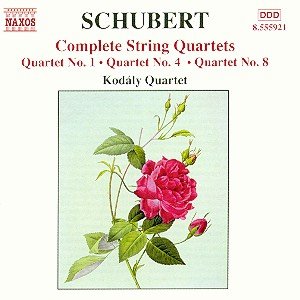Franz Schubertís prolific compositional output, given
his short and difficult life, is a miracle in and of itself. That he
was able to create all that he did without any real patronage and in
the very shadow of Beethoven (he outlived the giant from Bonn by barely
a year, and in the same city), speaks volumes to his genius and determination.
A melodist of supreme gifts, Schubertís large catalogue of songs is
amazingly consistent, each one beautiful and unique. In larger vehicles,
however, one often finds the composer wandering and overextending the
forms, especially in his later works.
In this, the fourth volume of the Kodaly Quartetís
survey of the fifteen Schubert quartets, we are treated to some early
examples of the composerís chamber music. Although he rarely had the
opportunity to hear his music performed by professionals, he was fortunate
to come from a musical family, and the quartet comprised of his father
and siblings enabled Schubert to hear his works played at least competently
and often. Two of the works on this disc are from his student days and
a third (D.112) was composed during the period of his training as a
schoolteacher. It was published posthumously as opus 168.
These are charming works, clearly modeled on the classical
examples of Haydn and Mozart. Quartet number eight, heard here as the
opening of the program, marks a step forward in Schubertís development
as a composer. There is greater thematic development than in earlier
examples and there is a more thought out contrast in moods. The first
quartet (D18), although not lacking in charm and invention, is quirky
in its choice of keys and somewhat underdeveloped themes. Quartet number
four, with its descending chromatic opening theme, first stated by the
cello then handed from player to player as it develops, is a direct
homage to Mozartís Dissonance quartet.
The Kodaly Quartet is a tight ensemble. They play here
with splendid verve and vigor, and their balance and intonation is superb.
Particularly pleasing is their classical approach to these early works,
while at the same time giving us a hint of the more romantic future
that would lie ahead for the composer. Melodic passages truly sing here,
and I was struck by this ensembleís ability to phrase like a singer.
These are very well constructed performances and are a most pleasurable
listen.
Naxosí engineers have captured the quartet in a warm,
resonant sound and the balance between the instruments is lovely. This
is a very natural sounding recording, not over-long on reverberation
yet sufficiently warm. Notes by Keith Anderson are succinct and informative.
Highly recommended.
Kevin Sutton


